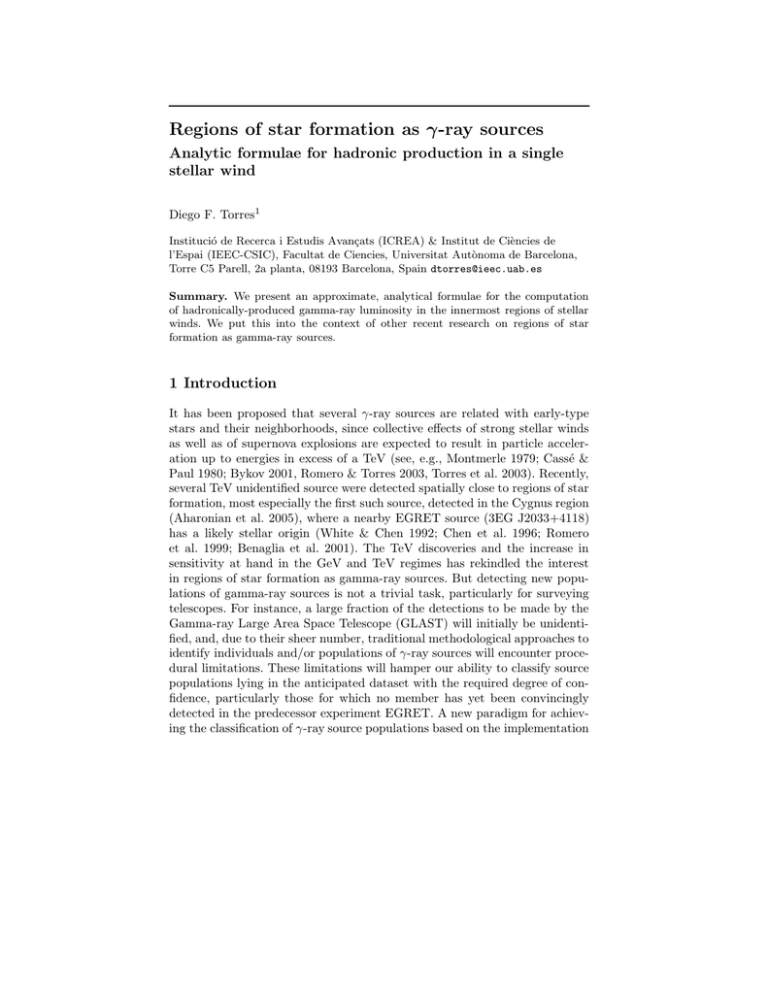Regions of star formation as γ-ray sources stellar wind Diego F. Torres
advertisement

Regions of star formation as γ-ray sources
Analytic formulae for hadronic production in a single
stellar wind
Diego F. Torres1
Institució de Recerca i Estudis Avançats (ICREA) & Institut de Ciències de
l’Espai (IEEC-CSIC), Facultat de Ciencies, Universitat Autònoma de Barcelona,
Torre C5 Parell, 2a planta, 08193 Barcelona, Spain dtorres@ieec.uab.es
Summary. We present an approximate, analytical formulae for the computation
of hadronically-produced gamma-ray luminosity in the innermost regions of stellar
winds. We put this into the context of other recent research on regions of star
formation as gamma-ray sources.
1 Introduction
It has been proposed that several γ-ray sources are related with early-type
stars and their neighborhoods, since collective effects of strong stellar winds
as well as of supernova explosions are expected to result in particle acceleration up to energies in excess of a TeV (see, e.g., Montmerle 1979; Cassé &
Paul 1980; Bykov 2001, Romero & Torres 2003, Torres et al. 2003). Recently,
several TeV unidentified source were detected spatially close to regions of star
formation, most especially the first such source, detected in the Cygnus region
(Aharonian et al. 2005), where a nearby EGRET source (3EG J2033+4118)
has a likely stellar origin (White & Chen 1992; Chen et al. 1996; Romero
et al. 1999; Benaglia et al. 2001). The TeV discoveries and the increase in
sensitivity at hand in the GeV and TeV regimes has rekindled the interest
in regions of star formation as gamma-ray sources. But detecting new populations of gamma-ray sources is not a trivial task, particularly for surveying
telescopes. For instance, a large fraction of the detections to be made by the
Gamma-ray Large Area Space Telescope (GLAST) will initially be unidentified, and, due to their sheer number, traditional methodological approaches to
identify individuals and/or populations of γ-ray sources will encounter procedural limitations. These limitations will hamper our ability to classify source
populations lying in the anticipated dataset with the required degree of confidence, particularly those for which no member has yet been convincingly
detected in the predecessor experiment EGRET. A new paradigm for achieving the classification of γ-ray source populations based on the implementation
2
Diego F. Torres
of an a priori protocol to search for theoretically-motivated candidate sources
is probably needed in order to protect the discovery potential of the sample (Torres & Reimer 2005). Key to the any new procedure is a statistical
assessment by which the discovery of a new population can be claimed under a similar quantitative technique. For the previously cited protocol, this
is achieved by introducing that the hypothesis to test in searching for new
population of sources is the null hypothesis against a reduced noise level. It
is useful to note that the LAT in GLAST will be in a privileged position to
actually identify new population of sources. If LAT would have an additional
order of magnitude better sensitivity, with no very significant improvement
in angular resolution, a situation similar to the GRB case would appear, i.e.,
a flat distribution of unidentified sources with a few privileged individuals
only which are extensively traced in multifrequency studies. Essentially, we
would find a γ-ray source coinciding with the position of every member of
any population under consideration. And thus, we would lack the capability
to achieve discoveries by correlation analysis. This is, perhaps, already indicating that a next generation high energy γ-ray mission after GLAST-LAT
should not be exclusively sensitivity-driven if no significant improvement in
angular resolution can be achieved.
2 Hadronic processes in single and collective winds
Regions that currently are or have been subject to a strong process of star
formation are good candidates to be γ-ray and neutrino emitters and may
even be sites where ultra high energy cosmic rays are produced (see Torres
& Anchordoqui 2005 for a review). Outside the Galaxy, the more powerful
sites of star formation are found within very active galaxies such as starbursts
and Luminous or Ultra-Luminous Infrared Galaxies, and they have also been
recently analyzed as high energy emitters (e.g. Torres et al. 2003, Torres 2004,
Torres et al. 2004ab, Cillis et al. 2005, Domingo-Santamaria & Torres 2005).
Here, we will not cover these results concerning collective effects in extragalactic scenarios, referring the reader to the mentioned publications for details.
Rather, we will make a short note on the computation of hadronic gamma-rays
in single and collective stellar winds.
Typically, a stellar wind consists of an inner region in free expansion,
followed by a larger, low dense region of hot shocked wind (bubble), which is
finally surrounded by a thin layer of swept-up interstellar medium (ISM) (see,
e.g., Lamers & Cassinelli 1999, Ch. 12). We assume that γ-ray production is
mainly hadronic and that it occurs at the end of the free expansion phase of
the wind evolution, when the swept-up matter is comparable with the mass in
1/2
, where
the wind driven wave. Its size is then Rwind = 3Ṁ? /4πmp n0 V∞
Ṁ? is the star mass loss rate, mp is the mass of the proton, n0 is the ISM
number density and V∞ is the wind terminal velocity. For a star of radius
Regions of star formation as γ-ray sources
3
R? the particle density and particle velocity radial profiles of the wind at
−β
this inner zone can be modeled by n(r) = (1 − R0 /r) Ṁ? /4πmp V∞ r2 , and
β
V (r) = V∞ (1 − R0 /r) , respectively. The parameter β is ∼ 0.8−1 for massive
stars, R0 is given by R0 = R? (1 − (V0 /V∞ )1/β ), and the wind velocity close to
the star, V0 , is typically ∼ 10−2 V∞ . As a first exercise, we can compute the
resulting γ-ray luminosity of a single star with the target matter being that
of the innermost region, and between energies E1 and E2 :
Lγ =
Z
Rwind
R?
Z
E2
n(r) qγ (Eγ )Eγ (4πr2 )dr dEγ ,
(1)
E1
with the differential γ-ray emissivity from π 0 -decays, qγ (Eγ ), approximated
by
(α)
qγ (Eγ ) = 4πσpp (Ep )(2Zp→π0 /α) Jp (Eγ )ηA Θ(Ep − Epmin )
(2)
at the energies of interest. The parameter ηA takes into account the contribution from different nuclei in the wind (for a standard composition ηA ∼ 1.5,
Dermer 1986). Jp (Eγ ) is the proton flux distribution evaluated at E = Eγ
(units of protons per unit time, solid angle, energy-band, and area), which is
assumed as a typical power-law Jp (Ep ) = (c/4π)Kp Ep −α , with α being the
spectral slope and Kp the spectrum normalization factor. The cross section
σpp (Ep ) for pp interactions at energy Ep ≈ 10Eγ can be represented above
Ep ≈ 10 GeV by σpp (Ep ) ≈ 30 × [0.95 + 0.06 log(Ep /GeV)] mb (e.g., Aharo(α)
nian & Atoyan 1996). Zp→π0 is the so-called spectrum-weighted moment of
the inclusive cross-section. Its value for different spectral indices α is given, for
instance, by Drury et al. (1994). Finally Θ(Ep − Epmin) is a Heaviside function
that approximately takes into account the fact that only CRs with energies
higher than Epmin (r R? ) will diffuse into the wind (see below). For normalization purposes, we take the expression of the proton energy density, which
is given by
Z
ωCR = Np (Ep )Ep dEp = {134.4 ; 9.9 ; 0.8}Kp eV cm−3 ≡ ςωCR, , (3)
where ς is the enhancement factor of the CR energy density with respect to
the local value, ωCR, , we have considered energies between 1 GeV and 20
TeV, and the choice for the prefactor, {134.4 ; 9.9 ; 0.8}eV cm−3 , refers to
three different slopes, 1.9, 2.0, and 2.1, respectively. If the prefactor is referred
as f (α) [with units of ωCR, , typically given in eV cm−3 ], the normalization
is Kp (α) ∼ ωCR, ς/f (α), depending on the slope of the spectrum. We assume
−2.75
the Earth-like spectrum to be J⊕ (E) = 2.2EGeV
cm−2 s−1 sr−1 GeV−1 , so that
−3
ωCR, ∼ 1.5 eVcm . An analytic expression for the γ-ray luminosity of a
single star produced in the innermost region of its wind can thus be obtained
if the radial dependence of the wind velocity is ignored. This, in fact, does not
introduce significant changes on the results because a) the terminal velocity
of the wind is reached in only a few star radii, and b) the integration extends
4
Diego F. Torres
to radii up to Rwind R? , with the largest radii (where most of the mass is
located) dominating the sum. The expression for the approximate luminosity
then reduces to:
(α)
Lγ ∼
"
9.6 × 10−38 c Ṁ? Zp→π0 ηA Kp (2)
(Rwind − R? ) ×
m p V∞ α
" 2 ##
2
E2
0.06
E2
E1
log
0.47 ln
+
− log
erg s−1 , (4)
E1
2 log e
eV
eV
for α=2, and
(α)
9.6 × 10−38 c Ṁ? Zp→π0 ηA Kp (α)
(Rwind − R? ) ×
Lγ ∼
m p V∞ α
"
2−α 2−α !
2−α E1
E2
E2
E2
0.06
0.47
−
ln
−
−
2−α
eV
eV
ln 10 (α − 2)
eV
eV
2−α !
2−α 2−α !#
E1
E1
E1
E2
0.06
ln
−
− 2
erg s−1
eV
eV
α − 4α + 4
eV
eV
for α 6=2, with the proton mass measured in kg, the terminal velocity and the
speed of light measured in cm s−1 , the mass loss rate measured in kg s−1 ,
and the wind and stellar radius given in cm. Analogously, the expected γ-ray
flux over an energy threshold Eth can be evaluated taking into account the
distance D from the Earth to the stellar association:
Z Rwind Z
1
n(r) qγ (Eγ ) 4πr2 dr dEγ .
(5)
Fγ (Eγ > Eth ) =
4πD2 R?
Eth
Also here an analytic –although approximate– expression, can be obtained:
(α)
−26
c Ṁ? Zp→π0 ηA Kp
1 6.0 × 10
(Rwind − R? ) ×
Fγ (E > Eth ) ∼
4πD2
m p V∞ α
"
1−α
1−α #
0.47 Eth
0.06 Eth
1
Eth
1
+
+
ln
α − 1 eV
ln 10 eV
α2 − 2α + 1 α − 1
eV
photons cm−2 s−1 ,
which is valid for all α 6= 1. Here, D must be given in cm, whereas all other
quantities must be given in the same units as those used in Eqs. (4) to respect
consistency with the numerical factor. This formulae are useful to fix the scale:
a typical single star would produce, by interaction between cosmic rays and
target matter in the innermost region of its wind, a flux one to three orders of
magnitude (depending on the kind of star) below the sensitivity achieved by
current telescopes in the TeV regime. Of course, this estimation does not take
Regions of star formation as γ-ray sources
5
into account other processes, particularly those happening in binary systems
where two strong stellar winds interact.
In the case of a collection of winds, a hydrodynamical model taking into
account the composition of different single stellar winds needs to be adopted.
As we see below, differences with the single stellar wind case are notable.
One possibility is to consider that there are N stars in close proximity, uniformly distributed within a radius Rc , with a number density n = 3N/4πRc3 .
Each star has its own mass-loss rate (Ṁi ) and (terminal) wind velocity
PN
(Vi ), and average values can be defined as Ṁw = 1/N × i Ṁi , and
P
1/2
N
2
Vw =
. All stellar winds may be assumed to mix with
i Ṁi Vi /N Ṁw
the surrounding ISM and with each other, filling the intra-cluster volume
with a hot, shocked, collective stellar wind. A stationary flow in which mass
and energy provided by stellar winds escape through the outer boundary of
the cluster is established. For an arbitrary distance R from the center of the
cluster, mass and energy conservation imply
4π 3
R nṀw = 4πR2 ρV ,
3
1 2
1 2
4π 3
R nṀw
Vw
V +h ,
= 4πR2 ρV
3
2
2
(6)
(7)
where ρ and V are the mean density and velocity of the cluster wind flow
at position R and h is its specific enthalpy (sum of internal energy plus the
pressure times the volume). Solving these equations with the corresponding
boundary conditions, one obtains the density and velocity of the cluster as
a function of distance from its center. This is presented in detail in the paper by Domingo-Santamaria & Torres (2006). Again, it is to be noted that
not all cosmic rays will be able to enter the collective wind. The difference
between an inactive target, as that provided by matter in the ISM, and an
active or expanding target, as that provided by matter in a single or a collective stellar wind, is indeed given by modulation effects. The cosmic ray
penetration into the jet outflow depends on the parameter ∼ V R/D, where
V is velocity of wind, and D is the diffusion coefficient. measures the ratio
between the diffusive and the convective timescale of the particles. Taking into
account such effects, we have studied collective wind configurations produced
by a number of massive stars, and obtained densities and expansion velocities of the stellar wind gas that is target for hadronic interactions in several
examples (see details in Domingo-Santamarı́a & Torres 2006). We have computed secondary particle production, electrons and positrons from charged
pion decay, electrons from knock-on interactions, and solve the appropriate
diffusion-loss equation with ionization, synchrotron, bremsstrahlung, inverse
Compton and expansion losses to obtain expected γ-ray emission from these
regions, including in an approximate way the effect of cosmic ray modulation
(see Torres & Domingo-Santamarı́a 2005 for details on the code). Examples
where different stellar configurations can produce sources for GLAST and the
6
Diego F. Torres
MAGIC/HESS/VERITAS telescopes in non-uniform ways, i.e., with or without the corresponding counterparts were found. Cygnus OB 2 and Westerlund
1 maybe two associations where this scenario could be at work
Acknowledgments
DFT has been supported by Ministerio de Educación y Ciencia (Spain) under grant AYA-2006-00530, and the Guggenheim Foundation. I thank E.
Domingo-Santamarı́a for comments.
References
1.
2.
3.
4.
5.
6.
7.
8.
9.
10.
11.
12.
13.
14.
15.
16.
17.
18.
19.
20.
Aharonian F. A. et al. 2005, A&A 31, 197
Aharonian F. A. & Atoyan, A. M. 1996, A&A 309, 91
Benaglia P., et al. 2001 A&A 366, 605
Bykov, A. M. 2001, Space Sci. Rev., 99, 317
Cassé, M. & Paul, J. A. 1980 ApJ, 237, 236
Chen, W., White, R. L., & Bertsch, D. 1996, A&AS, 120, 423
Cillis A. N., Torres D. F. & Reimer O. 2005, ApJ 621, 139
Domingo-Santamarı́a E. & Torres D. F. 2005, A&A 444, 403
Domingo-Santamarı́a E. & Torres D. F. 2006, A&A 448, 613
Lamers H. J. G. L. M., & Cassinelli, J. P. 1999, Introduction to Stellar Winds,
Cambridge University Press, Cambridge
Montmerle T. 1979, ApJ, 231, 95
Romero G. E., & Torres, D. F. 2003, ApJ, 586, L33
Romero, G. E., Benaglia, P., & Torres, D. F. 1999, A&A, 348, 868
Torres D. F., et al. 2003, Physics Reports, 382, 303
Torres D. F. 2004, ApJ 617, 966
Torres D. F., et al. 2004a, ApJ 607, L99
Torres D. F., Domingo-Santamarı́a E., & Romero G. E. 2004b, ApJ 601, L75
Torres D. F. & Reimer O. 2005, ApJ 629, L41
Torres D. F. & Domingo-Santamarı́a E. 2005 Mod. Phys. Lett. A20, 2827
White, R. L., & Chen W. 1992, ApJ, 387, L81


